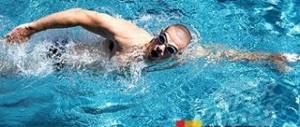History of origin and development
The founder of this sport is considered to be William J. Morgan, who worked as a physical education teacher at a college located in Holyoke, Massachusetts. The birthplace of volleyball is America. Back in 1895, a man decided to entertain his students: he stretched a tennis net in the middle of the gym and invited the children to throw an ordinary and rather large basketball over it. The net was stretched at a height of 2 meters.
It was from this moment that the history of volleyball begins, although at that time its inventor called the game mintonet. There were no rules then, the students simply threw the ball to each other and tried not to let it land on their field. The number of players on each side was not limited, which somewhat complicated the process.
A little later, the game was presented at a conference among various colleges in Springfield. One of the professors suggested calling it volleyball. Just 2 years after the invention of the mintonet, the first rules for a team sport appeared. The main ones were:
- the height at which the mesh is stretched is 198 cm;
- size of the playground - 7.6 m by 15.1 m;
- the circumference of the ball ranges from 25-27 inches;
- the weight of the game ball should not exceed 340 g;
- the number of people on the team at that time was quite large.
Thanks to the approval of the basic rules, the sport became more popular and competitions began to be held. Further, the technique of playing volleyball changed, new requirements and prohibitions were added. Most of the modern rules were formed between 1915 and 1925. The changes were approved in America, Africa, as well as in European countries. However, until the mid-20th century, Asia played by its own rules.
The first national competition was held in 1922 in Brooklyn. 23 teams, which consisted only of men, took part in them. The development of the game was rapid. Just 2 years after the competition, a basketball and volleyball union was created. The organization was the first in Europe. After this, national federations were formed in the USSR, America and other countries.
Post-war period
During the Second World War, the development of the game slowed down somewhat. Only in 1947 was the congress of the International Volleyball Federation held in Paris. The event was attended by 14 countries, including Belgium, Romania, France and others.
After 2 years, the first championship was held, to which men's teams were allowed . In 1951, a conference was held in Marseille, its leaders approved new rules and made some changes. It was allowed to hold competitions between women's and men's teams, and the entire game was played in 5 games.
In addition, an arbitration commission was organized, as well as a committee that was engaged in improving the rules and introducing them into the game. If you read a report on the development of this sport, you will find out that Paul Liebeau became the first president of the International Volleyball Federation. The French architect was re-elected several times until 1984. In 1957, the game was officially declared an Olympic sport.
A significant event in the history of volleyball was the first major competition between the men's and women's national teams, which was held at the next Olympics, held in Tokyo. It was after this event that a significant change was made to the rules of the game - it was allowed to touch the ball again after blocking it and move your hands over the net.
In 1970, after long negotiations, it was decided to introduce antennas at the edges of the grid. After 4 years, referees had the opportunity to show players yellow and red cards. Over the next decade, many competitions were held between different countries, the description of the game changed somewhat, and high school students began to actively play volleyball in physical education classes.
In addition, information appeared about innovations in this sport, domestic volleyball was actively developing, several strong teams were formed, whose players deserved to take a place in the national team.
Volleyball in the 1980s–1990s
About 90 years passed after its inception when the first president of the federation gave way to another person. It was Mexican lawyer Ruben Acosta. It was on his initiative that some changes were made aimed at increasing the popularity of matches and their telegenic nature by reducing the time of each game. Further it develops, the rules are adjusted:
- After the next conference, the tactics of the fifth party change.
- In the 1990s, the point limit for the first four games was set at 17.
- A few years later, a congress was held in Tokyo, at which it was decided to play the first 4 games to 25 points, and the fifth to 15.
- One of the revolutionary decisions in 1997 was the adoption of a project according to which each team was allowed to include a defender or libero player.
- A year before this event, official representatives of the International Federation allowed touching the ball with any part of the body, even the foot.
- The technique and tactics of the game are constantly being improved. Already in the early 1980s, the side serve was almost never used; most often it was carried out in a jump.
In addition, the functions of players are changing . After the first rules of the popular game appeared, the composition of the team was reduced and it included only 6 people. They played equally actively on the field, but now there were 2 finishers who performed important actions. The improvement of serve reception also became an important stage in the development of the game, a new technical method was born that allowed each team to work more efficiently.
In 1990, the World League for men's teams began to play, and the popularity of volleyball grew. After 3 years, similar competitions are held among women's teams, called the Grand Prix.
Modern sport
Today the game is one of the most popular on the planet. Teenagers, adults, people of different genders are interested in it. In 2020, experts counted about 220 national federations. It is believed that in Russia, America, Brazil, Italy, Poland, Japan and Serbia, volleyball as a sport is better developed than in other countries. The Polish national team is today the current champion among men's teams, the Serbian national team among women's.
In 2012, the International Federation was headed by the Brazilian Ari Graça. The President and his assistants are today developing new rules that will help improve the game and resolve issues related to violations on the playing field. Next year, different rules are introduced; it is proposed to play the game to 21 points in order to reduce its time. At the next competitions, the method is tested, but is not officially accepted.
Since 2013, video surveillance has been actively conducted at any competition and Olympics, allowing you to view a replay in the event of a controversial situation. This happens quite often, so innovation is necessary.
Physical education project on the topic “Volleyball”
Slide 1
Ministry of Education of the Russian Federation Municipal budgetary educational institution Secondary school No. 8 Completed by: students of grade 8 “B” Alina Podyan and Yaroslava Morozova Supervisor: physical education teacher Tatyana Ivanovna Voitova Project on physical education on the topic: “Volleyball”
Slide 2
Project activities. 1. Title page 2. Contents 3. Goals and objectives of the project 4. History of the development of volleyball 5. Development of volleyball in the USSR 5. Basic rules of the game 6. Safety precautions 7. Basic techniques 8. Violation of the rules 9. How does playing volleyball help? 10. Conclusion 11. References
Slide 3
Project goal: 1. Formation of a positive attitude towards sports through the game of volleyball. Objectives: 1. To familiarize students with the history of the game volleyball. 2.Attract students to sports. 3.Form healthy lifestyle habits. The relevance of the topic is that volleyball occupies a prominent place in the system of physical education; it is included in the curricula of all educational institutions. Introduction. Volleyball is a team sport that is very popular. Practicing this sport contributes to the development of many physical qualities: strength of the arms and shoulder girdle, jumping ability, reaction speed, coordination of movements in space and time.
Slide 4
Volleyball first appeared in the United States of America in 1895. This game was invented by physical education teacher William Morgan. Initially, volleyball was played with a rubber bladder, which was thrown over a rope stretched at a height of 198 cm, and later over a net. In 1947, the International Volleyball Federation (FIVB) was created. The development of volleyball has accelerated. European and world championships began to be held, and the European Champions Cup was played. In 1964, volleyball was included in the Olympic Games program. Currently, more than 110 countries are members of the FIVB.
Slide 5
Despite the fact that volleyball was invented in America, the game quickly took root and was loved in the USSR. And so much so that in Germany it was nicknamed Russian folk. After all, it was the Russian champions who gave the game unique properties: agility, athleticism, speed. Back in the 1920s, with the participation of American coaches, volleyball teams were organized in some Russian cities, and in 1922, Moscow became interested in this sport and included it in the training program. Young athletes everywhere began to compete in this sport. In all the republics of the Soviet Union, the game earned recognition, especially after its inclusion in the Spartakiad. Soviet champions took gold in world cups 4 times, became winners of international championships 6 times and European winners 12 times. After the collapse of the USSR, the history of volleyball in Russia does not end. In 1991, the All-Russian Volleyball Federation was created, which preserved the knowledge of Soviet instructors. Development of volleyball in the USSR
Slide 6
Volleyball is a team sports game in which two teams of 6 people play on a court measuring 18*9 m. Players of one of the teams try to pass or kick the ball to their opponents so that they cannot return it back without breaking the rules. A volleyball net divides the court into two equal halves. The mesh width is 1 m, height is 2.43 cm for men, 2.24 cm for women. The game consists of three or five games, each of which continues until one of the teams scores 25 points (with a difference of two points). The decisive third (fifth) game lasts until 15 points. Each team has the right to touch the ball three times, not counting the block, on its side of the court. The ball can be hit with any part of the body above the waist and with the foot. The ball remains in play until it touches the court, walls, ceiling, other objects, or until a player makes a mistake. For each goal won, the team receives 1 point. The players on the court form two lines: front and back. Players move in a clockwise direction.
Slide 7
During volleyball classes, you must have appropriate sportswear (T-shirt, shorts, socks, sneakers or sneakers with thin flexible soles). To avoid injuries, you should follow the safety rules: At the beginning of the lesson, do a warm-up, warm up your muscles and ligaments well. Inspect the playground to ensure there are no dangerous objects on it. Do not receive the ball from above with straight arms, do not point your thumbs forward. When receiving the ball from below, do not bend your arms at the elbow joints. Be careful not to get the ball under your feet. After jumping, land on bent legs in a wide stance.
Slide 8
In volleyball, there are five main techniques of the game: serving, receiving, passing, attacking and blocking. All of these elements combine with the player's different stances and movements. The stance is a comfortable starting position for a volleyball player: the legs are slightly bent, the weight of the body is evenly distributed on both legs, the torso is tilted forward. When moving, additional steps are used, which are performed forward, backward, right, left. The movement begins with the leg closest to the direction of movement (when moving to the right - from the right leg, when moving to the left - from the left). Such movements are used when the player has enough time and needs to move a short distance. The double step is used when quickly approaching the ball. Movements begin with the leg farthest to the direction of movement.
Slide 9
Running is used for relatively large movements, and jumping is used when performing offensive strikes and blocking. Movements should be included in the warm-up at every lesson. This can be running from various starting positions (sitting, lying, backwards, etc.); “snake” running, shuttle running, side step movements with imitation of playing techniques. The double step is used when quickly approaching the ball. Movements begin with the leg farthest to the direction of movement.
Slide 10
Passing the ball overhand with two hands is the main technique. The player must correctly approach the ball and choose the starting position. Technique: legs bent at the knees, one leg in front. The torso is vertical, arms are extended forward and upward and bent at the elbows, hands at face level. The hands form a “bucket”, the fingers are tense and slightly bent. When passing, the legs and arms are straightened, and the ball is given the desired direction.
Slide 11
Receiving the ball from below above you. A serve or attacking blow is usually received from below with both hands. To receive, the player takes a medium or low stance. The arms are straightened and lowered, the hands are connected “fist to fist” or “palm to palm.” The ball is placed on the lower part of the forearm (“cuff”) with simultaneous extension of the legs and torso forward and upward. Straight arms rise to chest level.
Slide 12
Bottom straight feed. A volleyball game begins with a serve. The player is located behind the baseline, throws the ball and, with one hand, directs it towards the opponent’s side so that the ball does not touch the net. Technique: the player stands facing the net, legs bent at the knees, left leg in front (if you are left-handed, then the right one), ball in left hand. The right hand is retracted to swing back, and the ball is thrown up 30-50 cm with the left hand. The ball is struck with a tense palm at waist level. After the strike, the player takes a step forward with his right foot. All feeds are divided into lower and upper. With top serves, the ball is struck at head level or above, and with lower serves, the ball is struck below head level. If the server is facing the net, the serve is straight, if sideways, it is a side serve.
Slide 13
Two-handed overhand pass while jumping. If the ball flies high after receiving the serve, then you can perform a jump pass. To do this, the player jumps up so as to meet the ball at his forehead. The arms straighten forward and upward, passing the ball in the desired direction and with a certain trajectory. The player then lands on bent legs in a wide stance.
Slide 14
Overhead pass in support position. If you need to pass the ball back, you should go under the ball, holding your hands above your head. Extending your legs, bending at the waist and straightening your arms up and back, perform a pass.
Slide 15
The direct strike is one of the most common techniques in volleyball technique. It consists of a run (one, two, three steps), a jump, a strike and a landing. In the last step of the run, the leg is placed forward on the heel, the other leg is placed next to it (stopping step), and the arms are pulled back. The player performs an active swing of his arms forward and up, his legs extend, and he jumps upward. When jumping, the right arm moves up and back, the left arm moves down along the body. The ball is hit with a tense palm (the hand is placed on the ball from behind and above). The player lands on bent legs.
Slide 16
Blocking. This is a playing technique in which the defending team prevents the ball from being transferred to its side when the opponent is attacking, by blocking its progress with any part of the body above the net, usually with the hands transferred to the opponent’s side within the rules. It is allowed to move your hands to the opponent's side when blocking to the extent that they do not interfere with the opponent before his attack or other game action. The block can be single or group (double, triple). Touching a block does not count as one of the three touches. Only those players who stand on the front line, that is, in zones 2, 3, 4, can block.
Slide 17
Violations of the rules Below are the most typical mistakes of the players and the coach. 1. When serving: 1) The player stepped into the court space with his foot. 2) The player threw and caught the ball. 3) After 8 seconds have passed after the referee’s whistle, the ball is given to the opposing team. 4) Touching the antenna with the ball. 5) Completed the serve before the referee's whistle.
Slide 18
Violations of the rules 2. During the rally 1) More than three touches were made. 2) Touching the top edge of the net by a player performing an active game action. 3) The back line player’s entry into the three-meter line when attacking. 4) Error on reception: double touching or holding the ball. 5) The antenna touches the ball upon impact. 6) Advance into the opponent’s playing half. 3. Regulations 1) Violation of arrangement. 2) Unsportsmanlike behavior of one of the players or coaches. 3)Touching the top edge of the grid.
Slide 19
Volleyball exercises develop in athletes valuable physical and high moral and volitional qualities: 1. will help strengthen the cardiovascular and respiratory systems; 2. develop endurance; 3. develop an eye; 4. help get rid of flat feet; 5. strengthen the muscles of the legs and pelvis; 6. when playing volleyball, the functioning of the musculoskeletal system improves, coordination of movement and posture improves; 7. These sports have a positive effect on people with diabetes and cardiovascular pathologies.
Slide 20
Volleyball is one of the most common games in Russia. The mass, truly folk character of volleyball is explained by its high emotionality and accessibility, based on the simplicity of the rules of the game and the simplicity of the equipment. A special advantage of volleyball as a means of physical education is its specific quality - the possibility of self-dosing the load, i.e. correspondence between the player’s preparedness and the load he receives. This makes volleyball a game accessible to people of all ages. Volleyball contributes to the development of a sense of collectivism, perseverance, determination, and determination; attention and quick thinking; ability to manage your emotions; improvement of basic physical qualities. CONCLUSION
Slide 21
Bibliography. 1. https://olgavzglyad.ru/bez-rubriki/4477/ 2. https://nsportal.ru/ap/library/drugoe/2015/12/03/proekt-po-voleybolu 3. https://kopilkaurokov .ru/fizkultura/presentacii/priezientatsiia-volieibol 4. https://infourok.ru/tvorcheskiy-proekt-voleybol-put-k-uspehu-1346898.html 5. https://mypresentation.ru/presentation/126127_volejbol_prezentaciya_po_fizkulture
Basic Rules
Those who decide to engage in such a sport should study the rules of volleyball and briefly take notes if they cannot remember everything at once. The most important rules will be the following:
- Today the size of the site is 18 m by 9 m and has a rectangular shape.
- In the middle there is a stretched mesh. Height for men - 243 cm, for women - 224 cm.
- The ball always has a spherical shape, its circumference does not exceed 67 cm, and its mass ranges from 260−280 g.
- Each team consists of 14 players; 6 people are allowed on the field at a time.
- The main goal of the game is to use attacking shots and a series of serves to hit the ball to the floor on the opponent’s section of the court. The ball is put into play by serving one of the players after drawing lots.
- Part of the court for each team is divided into 6 zones, each of which contains a player. There are no clear boundaries between them, but after each serve, players move to another zone, moving clockwise.
- The serve is usually performed by a person in the second or first zone. The ball may touch the net, but must not fly higher than the side antennas. If he goes beyond them, the point is awarded to the opponent. If it lands behind the net in the territory of the other team, the point is scored by the server. The jumping power serve in modern volleyball is the most effective technique.
- An important condition for a successful game is creating interaction between all team members, learning the basics of volleyball by everyone, and determining the function of each player.
- Reception of serves on the opposing team is carried out by players on the second line, but reception by other team members is not prohibited.
- The receiving team may only allow 3 touches and the same player is prohibited from touching the ball again during the serve. Holding the ball after receiving it from an opponent is strictly prohibited. The origin of this rule is unknown, but it has long been one of the main ones.
Players cannot create their own attacking or blocking techniques; they must all be approved in the main rules.
Violations and penalties
When serving and playing the ball, players can intentionally or accidentally break the rules, so there are a number of restrictions that are taken into account by the referee. When serving, it is prohibited to step on the court with your foot, toss or catch the ball. The ball must not touch the antenna.
When playing, the player is prohibited from touching the antenna or net; the number of touches should not exceed 3, but the block is not taken into account. Double touching of the same person is not allowed, as is holding the ball for a long time. Crossing the center line with the foot is considered a serious violation.
Players are strictly punished for unsportsmanlike behavior when they use force or any methods that are not prescribed in the rules of the game. There are several types of penalties for violating the rules:
- warning - the coach, the entire team or player is given a yellow card;
- The referee makes a remark by issuing a red card;
- expulsion - the player is expelled before the end of the game, and he is presented with a red and yellow card together;
- disqualification - the player is removed until the end of the match, the referee shows a separate yellow and red card.
The latter measure is considered an extreme measure and is used when a player does not listen to the referee’s recommendations and constantly breaks the rules.
Role of players
Each player is in his own position and performs a specific function. There are 5 types of players in volleyball.
There can be only one finisher or forward in a team. This person takes part in attack and reception, often serving as defenders. The main task of the finisher is to correctly receive the ball in his zone.
Diagonal players are the strongest, jumping, tall and active. As a rule, a team earns the bulk of points thanks to good diagonal play.
Center blockers are the tallest and most active players; they block the opponent's attacks and prevent the team from losing points.
Setters perform an important function because they take part in passes and anticipate the attacks of their teammates. The quality performance of this role is of great importance for the entire cast.
The libero or defender is usually at least 190 cm tall, which helps him block the opponent's serves. The rules of the game allow you to have two liberos on your team. The interaction of all members of the team allows you to win the competition.
What is the essence of volleyball?
The goal of volleyball is to move the ball using your hands over the net and into the opponent's half of the court, attempting to force the round one to touch the court or bounce out of bounds from any part of the opposing player. At that time, the opposing team must prevent the ball from entering its own half of the court.
Volleyball rules prohibit players from hitting the ball twice. Usually a team tries to organize an attack with three touches: the first is a reception and a simultaneous pass to the setter (the one standing under the net - zone 3), the second is a pass to the attacker, the third is a hit.
Victory goes to the team that won the most games (in total, from 3 to 5 sets are played, depending on the tournament).
Teams, site and technical aspects
There must be 6 players on the court at the same time. Substitutions are allowed throughout the match, but in one game (set) the coach can make a maximum of 6 substitutions.
Each player takes his own position, in the attack zone (next to the net) or in the defensive zone (back of the court behind the three-meter line). According to the rules in volleyball, there are 6 zones, each with its own number (see the picture below ). Players move in a clockwise direction.
The volleyball court has a rectangular shape measuring 18 by 9 meters. A net is stretched in the middle of the site at a height from the floor:
- For men - 2.43 m.
- For women - 2.24 m.
For schoolchildren of different ages, the height of the grid has the following values:
- Boys 11-12 years old – 2.20 m.
- Girls 11-12 years old – 2.00 m.
- Boys 13-14 years old – 2.30 m.
- Girls 13-14 years old – 2.10 m.
- Boys 15-16 years old – 2.40 m.
- Girls 15-16 years old – 2.20 m.
The circumference of a volleyball is 65-67 centimeters, and its weight is 250-280 grams.
Set of points
To score a point, the ball must hit the floor in the opponent's half of the field or go out of bounds from the opposing player - this is the main way to score points, but there are many other ways to replenish your piggy bank with points, for example:
- The opponent did not serve or served it incorrectly.
- The opponent was unable to hit the ball over the net with the last shot.
- The opponent stepped beyond the center line of the field or touched the top edge of the net during an attack.
- Improper execution of a pass (holding or grabbing the ball in your hands).
- Incorrect command transition.
Gain points when blocked. Players of the defending team can jump out and block the opponent’s shot, if after blocking the ball bounces in the opponent’s half of the field or goes out of bounds from them, then your team gets a point. If after the block the ball bounces into your half of the court, the point is awarded to the team opposite.
According to the rules, the game is played to 25 points, but if the score reaches this mark, and neither side has an advantage of 2 points, then the set continues until there is this required two-point difference.
Do you know? The longest game in volleyball lasted 48 minutes. It was a match of the Italian Championship (men), the teams “Cuneo” and “Sisley” played. The second set of the match ended with the score 54:52.
Depending on the level of competition, in volleyball the number of sets varies from 3 to 5. The last 5th game is played up to 15 points.
What are the types of rule violations in volleyball?
Volleyball is a dynamic sport, so participants may break the rules during the game. Violations in volleyball are considered:
- Touching the ball by one player twice in one play (the block is not taken into account).
- Stepping behind the baseline when serving.
- More than three team touches per play.
- Violations in the arrangement.
- Serving for more than 8 seconds from the moment the whistle blows.
- Touching the top edge of the grid.
- A spade beyond the center line of the field (the spade is fixed if the arm(s) and leg(s) are completely in the opponent’s half of the field.
- Unsportsmanlike behavior of volleyball players - hitting opponents, tripping them, etc.
- Conflicts with the refereeing team.






